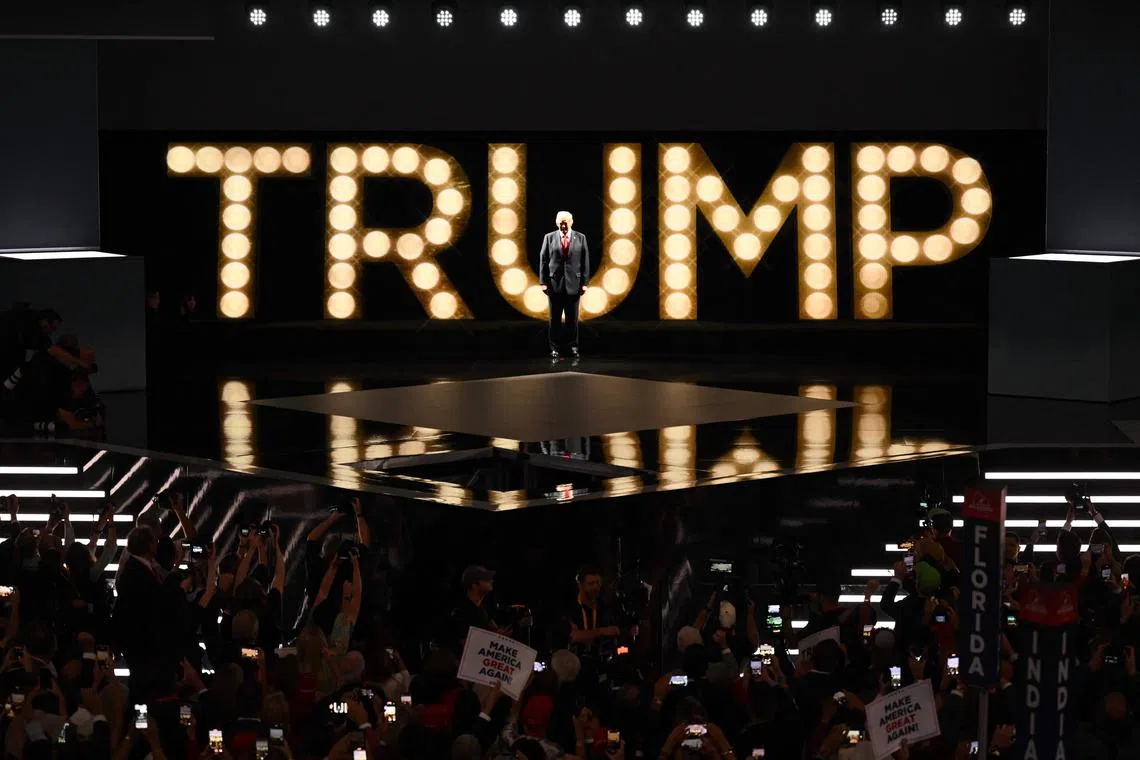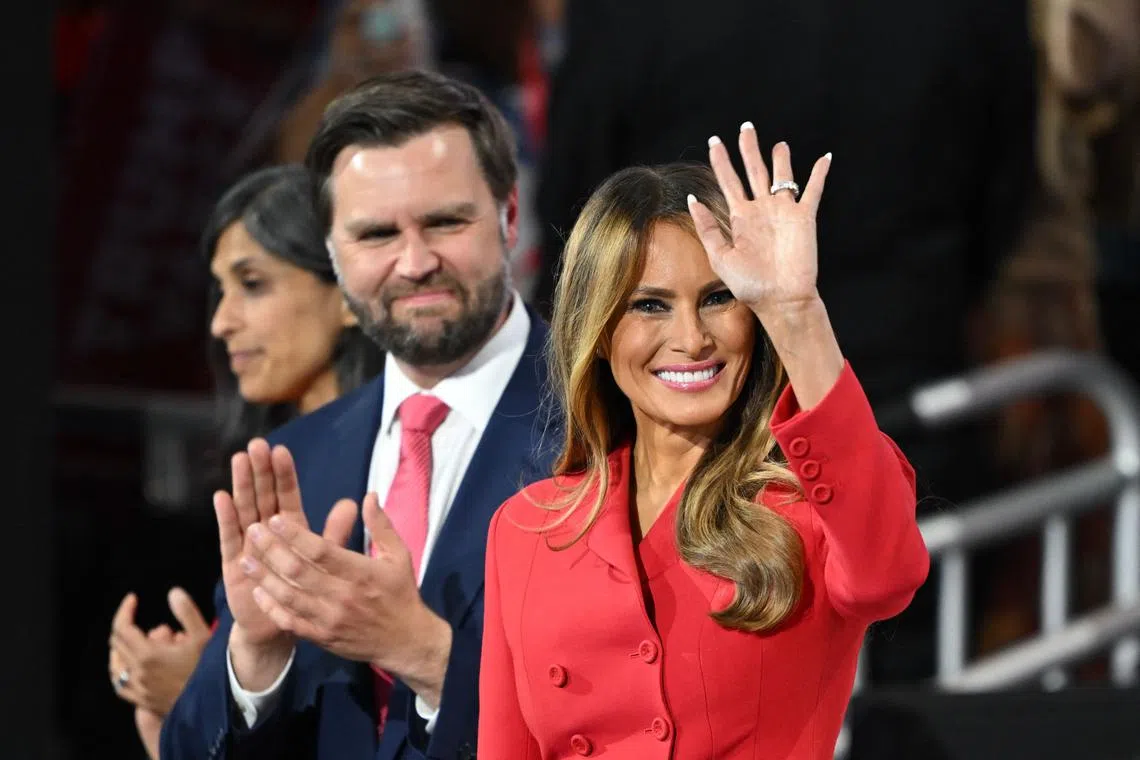Takeaways from the Republican National Convention
Sign up now: Get ST's newsletters delivered to your inbox

Donald Trump arrives onstage to accept his party's nomination on the last day of the 2024 Republican National Convention at the Fiserv Forum in Milwaukee, Wisconsin.
PHOTO: AFP
Follow topic:
MILWAUKEE - Donald Trump accepted the Republican presidential nomination before a raucous audience of thousands on July 18 (July 19 in Singapore), the crowning event to a gathering of the party’s faithful just days after the former president survived an assassination attempt.
Here are takeaways from the Republican National Convention.
Trump the unifier?
On the stump, Trump typically paints a dark portrait of America, railing against political opponents he says are corrupt, depraved and bent on destroying the country.
But in his convention speech
It is in some ways an unexpected strategy. Many of Trump’s opponents and even allies privately believed the attempt on Trump’s life on July 13 would only darken his rhetoric.
“The discord and division in our society must be healed. As Americans, we are bound together by a single fate and a shared destiny,” Trump said from the convention stage in Milwaukee. “We rise together. Or we fall apart.”
“I am running to be president for all of America, not half of America, because there is no victory in winning for half of America,” he said.
For most politicians, such rhetoric would be standard – even trite. For Trump, it represents a remarkable tonal shift.
One major question will be whether he sticks to the script or falls back to divisive rhetoric during his asides. Also to be seen is whether Trump is able to maintain a focus on unity in campaign events to come.
Family matters
Mrs Melania Trump, who has largely steered clear of Trump’s 2024 campaign, made a rare appearance in support of her husband on July 18 night.
She entered the arena to warm applause and waved to the crowd before taking a seat. Unlike at the Republican conventions in 2016 and 2020, she was not scheduled to speak.

Former first lady Melania Trump waves as she arrives during the last day of the 2024 Republican National Convention at the Fiserv Forum in Milwaukee, Wisconsin, on July 18, 2024.
PHOTO: AFP
The former first lady was joined in the family box by Trump’s daughter Ivanka and her husband, Mr Jared Kushner, who also have stayed away from the trail unlike in past campaigns.
The display of family harmony underscored an effort by the party this week to portray its nominee as a caring family man and selfless public servant who has been unfairly maligned by Democratic opponents who warn he could become a dictator if re-elected.
Trump’s teenage granddaughter Kai spoke on the night of July 17, and a grandchild sat on his knee in the family box on July 18.
It was also likely aimed at repairing the damage done to his image by his conviction in a hush-money trial in New York, where allegations of his affair with a porn star resurfaced and were the fodder of daily news reports.
Mrs Trump recently participated in two fund-raisers with the Log Cabin Republicans, a group of gay conservatives, but has otherwise barely been seen in public with her husband.
Image makeover
Trump’s speech capped four days of an intense image makeover by the party.
A stream of speakers talked about his warmth and empathy and some spoke of their previous misgivings about voting for him before seeing the light. Many noted his call for unity and not retribution following last weekend’s assassination attempt.
Watching the proceedings from a seat in the arena, Trump smiled and nodded at the recent converts as they spoke.
The intent of much of the televised event appeared to be to win over undecided voters who say they are not completely opposed to him but don’t like the drama that often surrounds him.
The image projected over the four days, however, was wildly at odds with how he is perceived by millions of Americans. Democrats and critics within his own party have condemned his often inflammatory and sometimes racist rhetoric, which includes threats of retribution against political opponents and deporting millions of migrants he says are “poisoning the blood” of the US.
Such rhetoric, however, also delights his diehard supporters, raising the question of whether Trump can maintain the image that Republicans worked so hard to create this week when he holds his first rally on July 20 with his newly minted vice-presidential pick, Senator J.D. Vance.
Are voters convinced?
All week, the Republicans said they were in Milwaukee to represent the forgotten men and women of the country. Trump’s problem is that many Americans have not forgotten the chaos of his 2017 to 2021 presidency and his efforts to overturn his 2020 election loss.
There are millions of Americans who will not consider voting for Trump under any circumstance. In polls conducted by Reuters/Ipsos and others, Trump has never amassed a majority of the country’s voters, even as Mr Biden has faced mounting doubts about his fitness for office.
Trump’s challenge remains bringing in those voters in the middle. His campaign insists that is beginning to happen, with so-called Democratic “safe states” such as Minnesota and Virginia seemingly coming into play. Some polls now show Trump and Mr Biden locked in tight races in those states.
Trump this week may have done little to improve his standing with suburban women voters, another important voting bloc. Mr Vance, for instance, has taken a more extreme stance on abortion in the past than Trump, something Democrats will look to exploit.
Ms Christine Matthews, a pollster who specialises in tracking women whose votes can go to either of the two major parties, said the pick of Mr Vance gives the ticket “a masculine energy” that might attract working-class men, particularly of colour, but could alienate women.
“This choice is a calculation that they will not be winning over women in the suburbs of Philly, Atlanta or Phoenix but might be able to push their margins up with non-college men of colour, particularly Hispanic men who on key cultural issues are closer to white men,” Ms Matthews said. REUTERS

